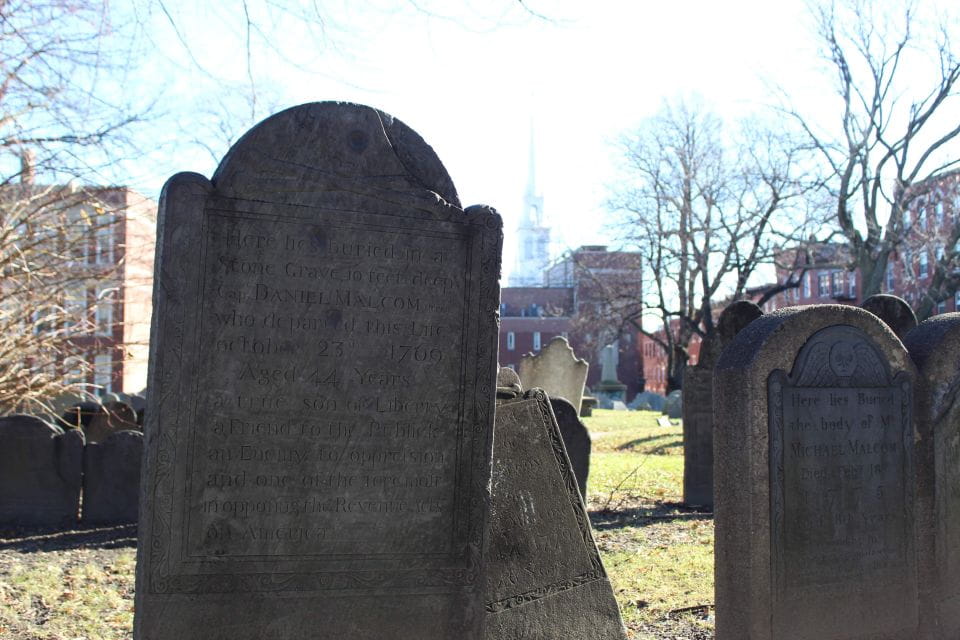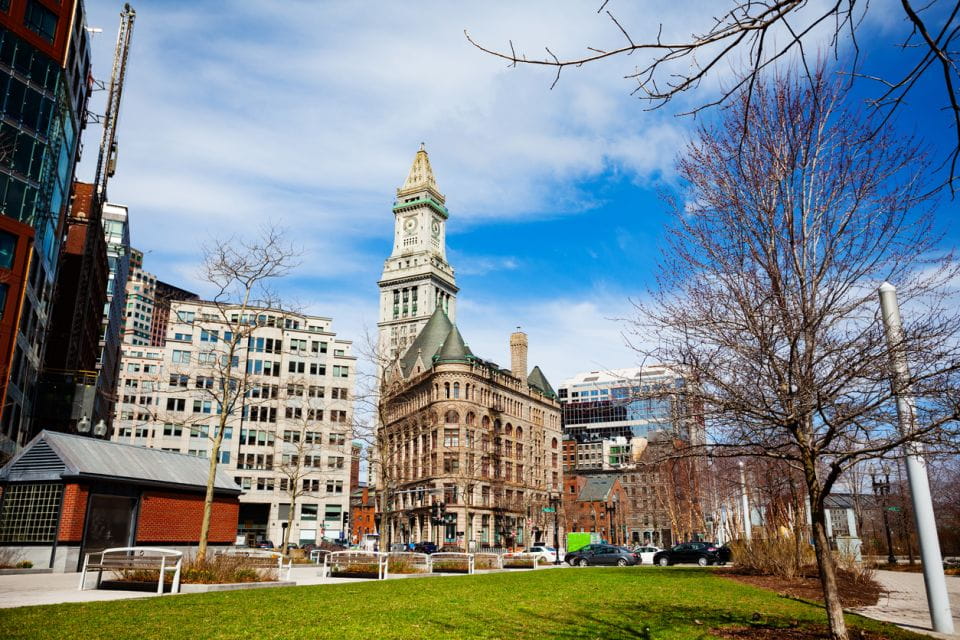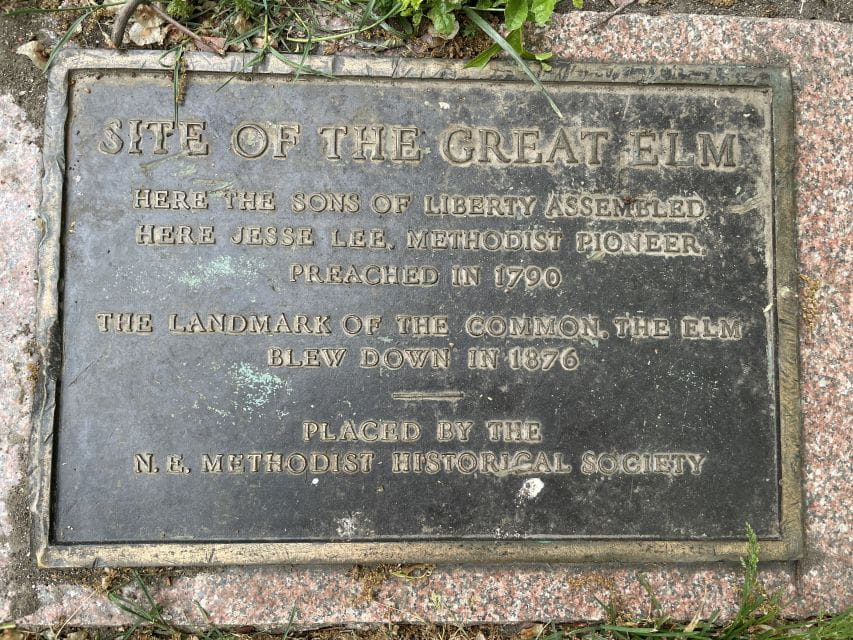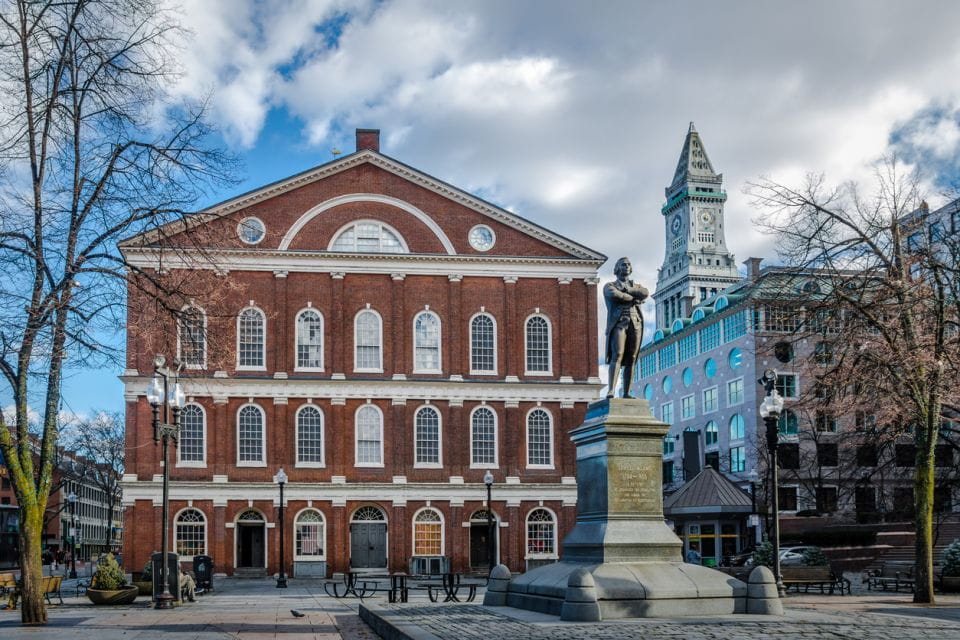Steeped in revolutionary history, Boston’s historic sites offer visitors a captivating window into the city’s pivotal role in America’s fight for independence. From the hallowed grounds of Copp’s Hill Burying Ground to the iconic Old North Church, these landmarks inspire awe and reflection on the brave actions that transformed the course of a nation. As you explore Boston’s rich tapestry of stories, you’ll uncover the meticulously preserved Paul Revere House, the vibrant Little Italy neighborhood, and the enduring legacy of Faneuil Hall – the "Cradle of Liberty." What secrets and surprises await as you explore the city that birthed a revolution?
Key Points

- Explore Copp’s Hill Burying Ground, the final resting place of notable figures like Cotton Mather, and learn about its role in the American Revolution.
- Discover the iconic Old North Church, where two lanterns signaled the British approach, sparking Paul Revere’s famous midnight ride.
- Visit the meticulously preserved Paul Revere House, and gain insight into the life and contributions of the legendary patriot.
- Enjoy the vibrant Little Italy neighborhood, shaped by the ‘Big Dig’ infrastructure project, and its rich Italian-American heritage.
- Explore Faneuil Hall, the ‘Cradle of Liberty,’ where Samuel Adams and other patriots delivered speeches that fueled the fight for independence.
Exploring Copp’s Hill Burying Ground

As visitors make their way through the winding paths of Copp’s Hill Burying Ground, they’ll uncover a wealth of colonial and Revolutionary history etched into the weathered gravestones.
Founded in 1660, this historic cemetery is the final resting place of notable figures like Cotton Mather, a minister involved in the Salem Witch Trials.
Strolling past the ornate headstones, guests can envision the bustling streets of 18th-century Boston and the critical role this neighborhood played in the American Revolution.
From here, the Freedom Trail leads visitors to the nearby Old North Church, where Paul Revere began his famous midnight ride to warn of the British invasion.
Copp’s Hill Burying Ground offers a striking introduction to Boston’s rich revolutionary past.
Fascinated by Boston's past? More historical tours we've covered
Unveiling the Old North Church

From the historic Copp’s Hill Burying Ground, visitors can make their way to the iconic Old North Church, a towering landmark that holds a cherished place in the annals of the American Revolution.
Inside this magnificent structure, they’ll be transported back in time as they learn about the fateful night in 1775 when Paul Revere and two other riders dashed through the streets, carrying the message that the British were marching.
Visitors can climb the church’s steeple and see the two lanterns that were hung, signaling the British troops’ approach by sea.
The Old North Church stands as a testament to the bravery and ingenuity of those who fought for American independence.
Discovering the Paul Revere House

Just down the road from the Old North Church lies the Paul Revere House, a humble yet historically significant structure that offers visitors a captivating glimpse into the life of the legendary patriot.
Stepping inside this meticulously preserved 17th-century home, one can almost hear the echoes of Revere’s footsteps as he prepared for his famous midnight ride to warn the Colonies of the British army’s approach.
The Paul Revere House provides a unique opportunity to:
- Explore the rooms where Revere and his family lived and worked.
- Learn about the silversmith’s craft and the role it played in Revere’s life.
- Discover the hidden passageways and architectural details that have stood the test of time.
- Gain a deeper appreciation for the sacrifices and contributions of this iconic figure in American history.
Navigating Little Italy and the ‘Big Dig’
Leaving the Paul Revere House, visitors can now enjoy the aromas and atmosphere of Boston’s Little Italy, a vibrant neighborhood known for its family-owned eateries, bustling bakeries, and the remnants of a once-thriving Italian-American community.
As you wander the narrow streets, you’ll find yourself surrounded by the sights and sounds of a lively immigrant enclave – the clang of cafe tables, the chatter of locals, and the tempting scents of fresh-baked bread and simmering tomato sauce.
Little Italy is also a neighborhood in transition, with the Rose Kennedy Greenway slicing through its heart, a result of Boston’s ambitious ‘Big Dig’ infrastructure project that reshaped the city’s landscape.
More Great Tours NearbyDelving Into Faneuil Hall’s Legacy

As visitors continue their exploration of Boston’s historical landmarks, Faneuil Hall emerges as a testament to the city’s pivotal role in the American Revolution. This iconic marketplace and meeting hall, often referred to as the ‘Cradle of Liberty,’ has long been a hub for civic engagement, political discourse, and the fight for independence. Within its walls, generations of Bostonians have gathered to voice their concerns, debate the issues of the day, and rally support for the revolutionary cause.
Key highlights at Faneuil Hall include:
- The Great Hall, where Samuel Adams and other patriots delivered impassioned speeches.
- The bronze statue of Samuel Adams, a prominent leader in the independence movement.
- The commemorative plaques that recount the hall’s pivotal role in the Boston Massacre and Boston Tea Party.
- The opportunity to stand in the very space where history was made and feel the weight of its legacy.
Loving the local insights? Here are more guided experiences we recommend in Boston
Samuel Adams and the Fight for Independence

Samuel Adams, a towering figure in Boston’s revolutionary legacy, spearheaded the fight for American independence with his fiery rhetoric and unwavering commitment to the cause.
From the halls of Faneuil Hall to the streets of Boston, Adams rallied the masses, igniting the spark that would ultimately lead to the formation of the United States.
As a fierce proponent of liberty, he galvanized public opinion against the British, organizing protests and boycotts that demonstrated the growing colonial resistance.
Adams’ rousing speeches and his role in the Boston Massacre trials further cemented his reputation as a champion of the people, inspiring generations of patriots to follow in his footsteps and fight for their freedom.
Remembering the Irish Famine Memorial

The Irish Famine Memorial stands as a poignant reminder of the choices faced by countless families during the devastating 19th-century potato famine, a crisis that forced millions to flee their homeland in search of a better life.
The memorial depicts a family of four, their emaciated figures serving as a haunting symbol of the desperation and heartbreak experienced during this dark period.
As you approach the memorial, you’ll notice four key elements that capture the essence of this tragedy:
- The gaunt, hollow-eyed figures representing the ravages of starvation.
- The elderly father, clutching a tattered document, a reminder of the difficult decisions forced upon them.
- The mother, shielding her children, embodying a mother’s unwavering love and resilience.
- The sense of uncertainty and the unknown future that lay ahead for these displaced souls.
Visiting the Granary Burying Ground

After paying respects at the poignant Irish Famine Memorial, visitors can stroll over to the Granary Burying Ground, one of the oldest cemeteries in Boston and the final resting place of several notable American historical figures. Wandering through the historic gravestones, travelers will come across the tomb of John Hancock, one of the Founding Fathers and the first signer of the Declaration of Independence. Nearby lies the grave of Samuel Adams, the fiery statesman and brewer who helped ignite the American Revolution. The cemetery also contains the remains of other Revolutionary heroes like the parents of Benjamin Franklin. Exploring this hallowed ground provides a tangible connection to Boston’s storied past.
| Historical Figure | Significance |
|---|---|
| John Hancock | Founding Father, first signer of Declaration of Independence |
| Samuel Adams | Statesman, brewer, revolutionary leader |
| Benjamin Franklin | Founding Father, polymath, inventor |
Frequently Asked Questions

How Long Does the Full Audio Tour Typically Take to Complete?
The full audio tour typically takes 2-3 hours to complete, allowing travelers to explore Boston’s rich history at their own pace and explore the city’s key neighborhoods and landmark sites.
Are There Any Discounts Available for Visiting the Historic Sites?
Many historic sites in Boston offer discounts for students, seniors, and those with military IDs. Some also have free admission days or special package deals to explore multiple attractions at a reduced cost.
Can Visitors Take Photographs Inside the Buildings and Cemeteries?
Visitors are generally allowed to take photographs inside the historic buildings and cemeteries during their exploration, though some sites may have specific restrictions. It’s best to check with staff upon arrival to ensure compliance with any rules.
What Are the Best Times of Day to Avoid Crowds at the Popular Attractions?
The best times to avoid crowds at popular Boston attractions are typically early morning or late afternoon. Weekdays also tend to be less crowded than weekends. Visitors should plan their schedule accordingly for a more enjoyable experience.
Are There Any Guided Group Tours Available for the Freedom Trail?
Yes, there are several guided group tours available for exploring the Freedom Trail in Boston. These tours provide an in-depth, expert-led experience to discover the city’s rich colonial and revolutionary history along the iconic 2.5-mile trail.
Recap
Boston’s historic sites transport visitors back in time, showcasing the city’s pivotal role in the American Revolution.
From the hallowed grounds of Copp’s Hill Burying Ground to the iconic Faneuil Hall, these landmarks embody the spirit of liberty and civic engagement that defined Boston’s past.
Exploring this rich tapestry of history and culture offers a captivating journey through the city’s enduring legacy as a beacon of independence and diversity.
You can check availability for your dates here:More Guided Tours in Boston
More Tours in Boston
- Boston History & Highlights Afternoon Tour
- Boston Delicious Donut Adventure by Underground Donut Tour
- Boston: North End to Freedom Trail Food and History Tour
- Boston Top 10 Freedom Trail & Cheers Landmark Tour
- From Boston: Full-Day Historical Lexington & Concord Tour
- From NYC: Boston and Harvard University Guided Day Tour
More Tour Reviews in Boston
Not for you? Here's more things to do in Boston we have recnetly reviewed
- Boston: Beacon Hill True Crime Walking Tour
- Boston Small-Group Freedom Trail History Tour Pub Crawl
- Boston: Go City Explorer Pass Including 2 to 5 Attractions
- Boston: Dog-Friendly Halloween Costume & Sightseeing Cruise
- Downtown Boston Harbor Weekend Cruise With Brunch
- The Boston Food Experience Walking Tour
- Boston: Guided Day Trip to Salem by Ferry
- Best of Boston: Full-Day Private Tour
- Boston: North End to Freedom Trail – Food & History Walking Tour
- Boston CityPASS®: Save 45% at 4 Top Attractions
- Boston: Hop-On Hop-Off Boston Sightseeing Tour With 24 Stops
- Boston: Ghost Tour
